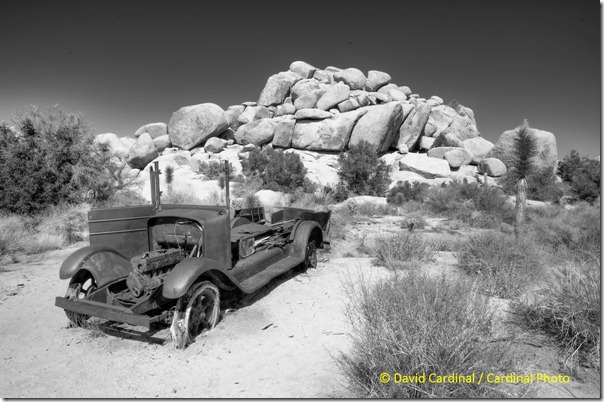- Photo Safaris
- Alaska Bears & Puffins World's best Alaskan Coastal Brown Bear photo experience. Small group size, idyllic location, deluxe lodging, and Puffins!
- Participant Guestbook & Testimonials Candid Feedback from our participants over the years from our photo safaris, tours and workshops. We don't think there is any better way to evaluate a possible trip or workshop than to find out what others thought.
- Custom Photo Tours, Safaris and Personal Instruction Over the years we've found that many of our clients & friends want to participate in one of our trips but the dates we've scheduled just don't work for them or they'd like a customized trip for their family or friends.
- Myanmar (Burma) Photo Tour Myanmar (Burma) Photo Tour December 2017 -- with Angkor Wat option
- Reviews Go hands-on
- Camera Reviews Hands-on with our favorite cameras
- Lens reviews Lenses tested
- Photo Accessories Reviews Reviews of useful Photo and Camera Accessories of interest to our readers
- Useful Tools & Gadgets Handy tools and gadgets we've found useful or essential in our work and want to share with you.
- What's In My Camera Bag The gear David Cardinal shoots with in the field and recommends, including bags and tools, and why
- Articles About photography
- Getting Started Some photography basics
- Travel photography lesson 1: Learning your camera Top skills you should learn before heading off on a trip
- Choosing a Colorspace Picking the right colorspace is essential for a proper workflow. We walk you through your options.
- Understanding Dynamic Range Understanding Dynamic Range
- Landscape Photography Tips from Yosemite Landscape Photography, It's All About Contrast
- Introduction to Shooting Raw Introduction to Raw Files and Raw Conversion by Dave Ryan
- Using Curves by Mike Russell Using Curves
- Copyright Registration Made Easy Copyright Registration Made Easy
- Guide to Image Resizing A Photographers' Guide to Image Resizing
- CCD Cleaning by Moose Peterson CCD Cleaning by Moose Peterson
- Profiling Your Printer Profiling Your Printer
- White Balance by Moose Peterson White Balance -- Are You RGB Savvy by Moose Peterson
- Photo Tips and Techniques Quick tips and pro tricks and techniques to rapidly improve your photography
- News Photo industry and related news and reviews from around the Internet, including from dpreview and CNET
- Getting Started Some photography basics
- Resources On the web
- My Camera Bag--What I Shoot With and Why The photo gear, travel equipment, clothing, bags and accessories that I shoot with and use and why.
- Datacolor Experts Blog Color gurus, including our own David Cardinal
- Amazon Affiliate Purchases made through this link help support our site and cost you absolutely nothing. Give it a try!
- Forums User to user
- Think Tank Photo Bags Intelligently designed photo bags that I love & rely on!
- Rent Lenses & Cameras Borrowlenses does a great job of providing timely services at a great price.
- Travel Insurance With the high cost of trips and possibility of medical issues abroad trip insurance is a must for peace of mind for overseas trips in particular.
- Moose Peterson's Site There isn't much that Moose doesn't know about nature and wildlife photography. You can't learn from anyone better.
- Journeys Unforgettable Africa Journeys Unforgettable -- Awesome African safari organizers. Let them know we sent you!
- Agoda International discounted hotel booking through Agoda
- Cardinal Photo Products on Zazzle A fun selection of great gift products made from a few of our favorite images.
- David Tobie's Gallery Innovative & creative art from the guy who knows more about color than nearly anyone else
- Galleries Our favorite images
Photographing Joshua Tree National Park
Photographing Joshua Tree National Park
Submitted by David Cardinal on Wed, 10/20/2010 - 10:21
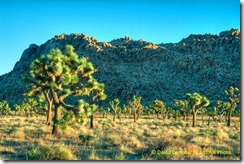 I’d driven around and nearly through Joshua Tree National Park many times and photographed the iconic Joshua Trees in the Mojave in the past, but this week I finally made the time to spend a couple quality days in Joshua Tree itself and I’m really glad I did. If you’re a fan of these crazy trees or of equally crazy boulder formations read on to get some idas of how to make the most of your visit there…
I’d driven around and nearly through Joshua Tree National Park many times and photographed the iconic Joshua Trees in the Mojave in the past, but this week I finally made the time to spend a couple quality days in Joshua Tree itself and I’m really glad I did. If you’re a fan of these crazy trees or of equally crazy boulder formations read on to get some idas of how to make the most of your visit there…
Aside from cacti most of the tree in Joshua Tree are just that, Joshua Trees. These trees look like some sort of enlarged brother cactus but are apparently related to lilies. Their thick trunks and spikey “leaves” give them a unique look somewhere between a palm tree and a cactus. You should probably decide you like them or at least have an open mind before you visit the park as you’ll be seeing plenty of them.
The Park’s unique location between the Mojave Desert to the North and the Sonoran Deserts to the South and East gives it a unique landscape including miles of Joshua Trees, some other worldly patches of Cholla Cactus and jumbles of railroad car sized boulders strewn about. Like with most landscape opportunities sunrise and sunset are the prime shooting times, but especially with the use of HDR techniques you can really shoot most times of day although the mid-day might best be reserved for some down time or scouting locations for sunset and sunrise.
Park Logistics
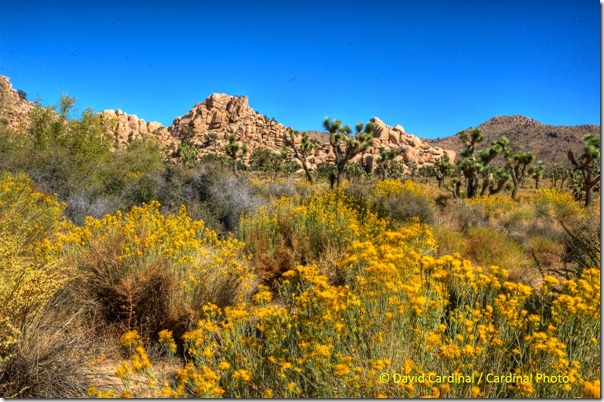
Fall isn’t the best time for flowers in the desert, but there are still some flowering weeds to showcase.
Joshua Tree is a big park. Not sprawling like Death Valley, but a lot more spread out than the compact Yosemite Valley for example. The Southern portion of the park has less going for it so typically visitors base either from the Northwest at Joshua Tree (the town) or the Northeast from Twenty Nine Palms. There are some chain motels along the road between the two towns but I really enjoyed staying at the Desert Lily B&B owned and run by the very helpful Carrie Yeager who has a great supply of books about the area as well as loaner water bottles and backpacks for those flying in. It is right next to the park and breakfast on their patio was perfectly time for after a sunrise shoot.
There are some good places to eat in both towns, especially the Crossroads Café in Joshua Tree and the Twenty Nine Palms Inn in Twenty Nine Palms. Make sure and gas up as well since there are no services in the park. There are some gorgeous campgrounds in the park as well but no other services.
Sunrise
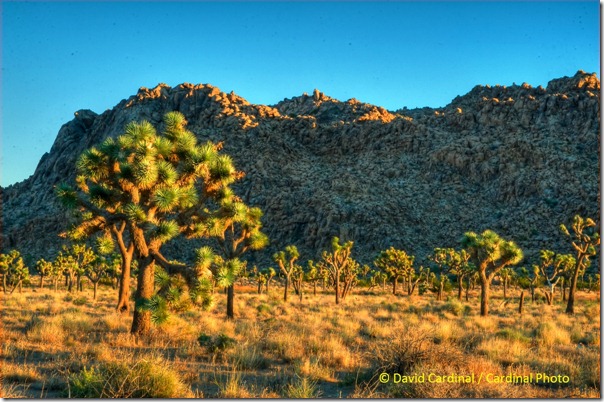
Sunrise provides an opportunity to showcase the Joshua Tree fields against shadowed hillsides.
I didn’t have any clouds the whole time I was there so sunrise was mostly a composition of rocks and trees against the blue sky which I wrote about earlier. It is certainly the best time to capture the unique texture of the Joshua Trees before the brighter light of mid-day turns them two dimensional.
Sunset
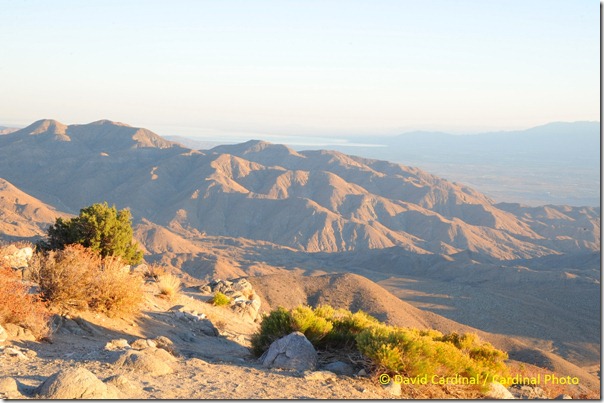
Even through the haze the view from Keys View at sunset is spectacular.
Salton Sea is in the Background.
The classic place to view sunset is Keys View. At over 5,000 feet it can be cool up there but the view stretches practically forever. You can see most of the Salton Sea and the mountains to the south on the Mexican Border. To the North you can see past Los Angeles. Smog and haze have cut down the view over the years but it is still stunning. It is hard to create compelling photographs there without clouds but the experience is worth the drive up. It is also one of the few places in the park with cellphone reception.
Mining Relics
While there is nothing even remotely similar to Scotty’s Castle in Death Valley there are some abandoned mines and mining equipment in the park. Wall Street Mine is one of the easiest to walk to, where I found this abandoned truck:
Boulders
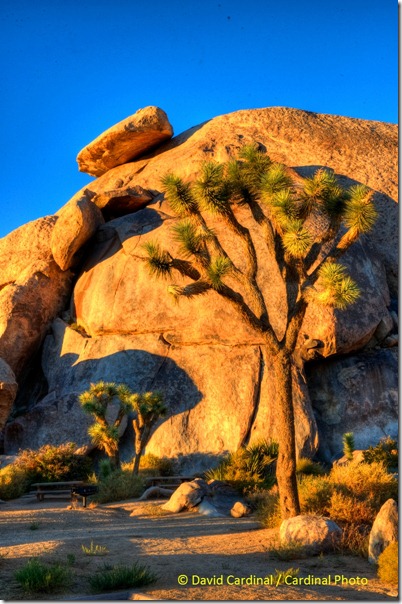
The raking light of sunset can help create contrast with shadows.
Along with the Joshua Trees one of the unique features of Joshua Tree is the weird looking “boulder piles.” Some of them have worn down to being not much more than rockpiles but many still feature insanely large boulders which make great backgrounds for your Joshua Tree photographs.
Cholla Cactus
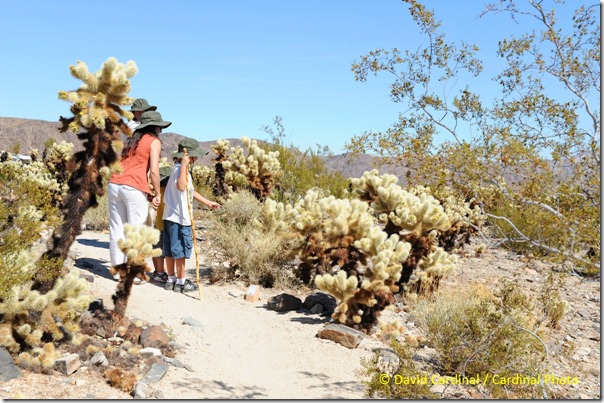
The Cholla Garden is a hit with kids. Just watch the thorns!
Photo taken with Nikon D700 and Sigma 24-70mm f/2.8 HSM Lens
The Cholla Cactus garden located near the center of the park looks almost like a coral reef. These cuddly looking cacti are actually really nasty to the unwary so while they are amazing to photograph I can warn you from experience not to get so absorbed in your image that you accidently back into one! They look great both front lit and back lit with the light making a near halo around the plants.
Joshua Trees
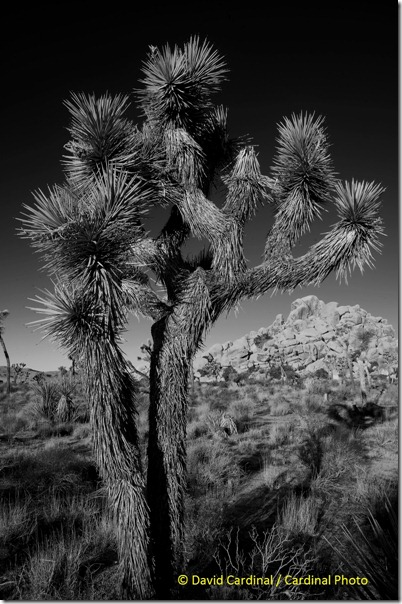
Joshua Trees can make some intriguing Black and White Images
And of course the signature plant of the park is the real star of many of the images you’ll be making. Their spiny leaves and trunks are interesting all by themselves but in addition each one has a unique overall shape. The trick is not just finding an interesting one or two to isolate as your subject but orienting them in your frame so that their shapes are visible against the background. Because so much of the desert has the same muted earth tones for coloring it is crucial to use lighting and shapes to create the contrast in your image. Your eye may see all the details of the trees but if you place them against a similarly lit background it will disappear. So look for situations where they are either framed against the blue sky or against shaded rocks or some other highly contrasting background.
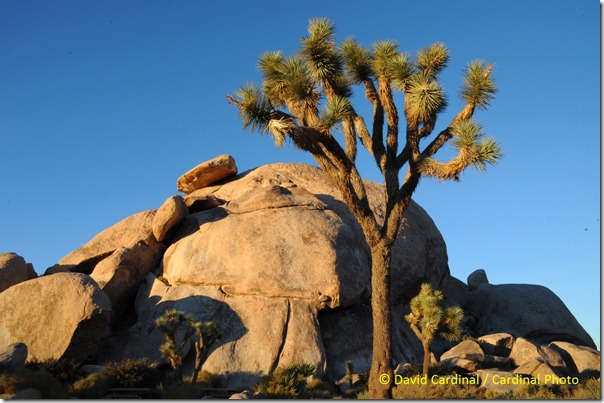
This “Cap Rock” image shows how the Joshua Trees and Boulders contrast with the sky.
Nikon D700 with Sigma 24-70mm f/2.8 HSM Lens.
Star Trails
A great way to end your day is with Star Trails. You can see some of the star trail images I took in Joshua Tree and read about how you can make similar images in the Guide to Digital Star Trails that I published to the B&H Blog site.
Photo Gear
I used my full frame Nikon D700 almost exclusively, but any reasonable D-SLR will work fine. I was also using my Sigma 24-70mm f/2.8 HSM Lens for most of my wide-angle shots although the New Nikon 24-120mm f/4 AF-S VR Lens or Nikon 28-300mm Lens (if you’re shooting DX then the Nikon 18-200mm Lens is the equivalent) would be very good options. Equally important, especially if you are planning to do any HDR work is a good tripod. I always use my RRS BH-55 as my head for landscape photography and for travel I rely on my Gitzo 3541LS legset. The combination is pricey but over the years no investment in photo equipment pays off any better. (If you’re in the market B&H has a $40 rebate offer on the Gitzo 3541LS legset.). A longer lens is helpful for some scenics and of course if you want to try to capture the abundant quail and antelope ground squirrels that frequent the park and surrounding areas.
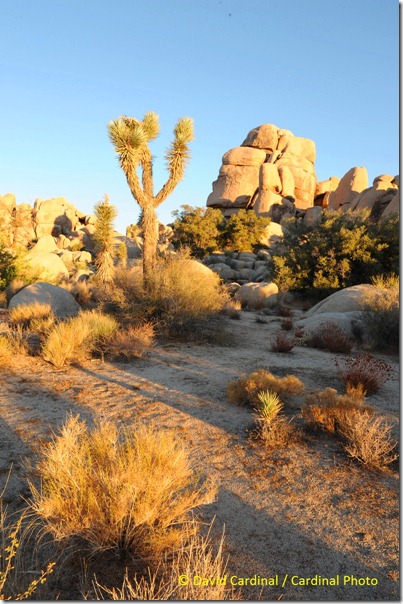
Combination of Joshua Tree & Boulders at Sunrise
Nikon D700 with Sigma 24-70mm f/2.8 Lens
- Log in to post comments

